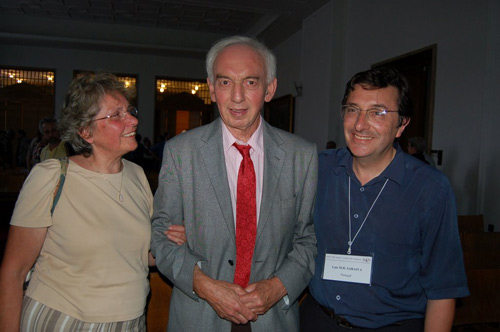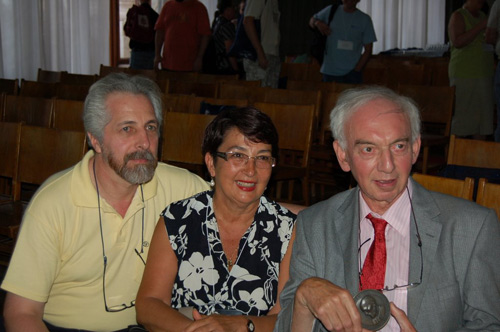Awarding of the Kenneth O. May Prize to Ivor Grattan-Guinness and Radha Charan Gupta
On the Occasion of the 23rd International Congress of History of Science and Technology
Craig Fraser presenting the sixth Kenneth O. May Medal to Ivor Grattan-Guinness at the 23rd International Congress of History of Science and Technology in Budapest, Hungary, 2009
Text of the Citations read by Craig Fraser, Chair ICHM
In 1989, the International Commission for the History of Mathematics awarded, for the first time, the Kenneth O. May Prize in the History of Mathematics. This award honors the memory of Kenneth O. May, mathematician and historian of mathematics, who was instrumental in creating a unified international community of historians of mathematics through his tireless efforts in founding in 1971 the International Commission for the History of Mathematics and in 1974 the ICHM's journal, Historia Mathematica. The Kenneth O. May Prize has been awarded every four years since 1989 to the historian or historians of mathematics whose work best exemplifies the high scholarly standards and intellectual contributions to the field that May worked so hard to achieve. To date, the following distinguished historians of mathematics have been recognized for their work through receipt of the Kenneth O. May Prize, which includes a medal cast in bronze and designed by the Canadian sculptor, Salius Jaskus:
- 1989, Dirk J. Struik (United States) and Adolf P. Yushkevich (Soviet Union)
- 1993, Christoph J. Scriba (Germany) and Hans Wussing (Germany)
- 1997, René Taton (France)
- 2001, Ubiratàn D'Ambrosio (Brazil) and Lam Lay Yong
- 2005, Henk Bos (The Netherlands)
On behalf of the International Commission for the History of Mathematics, it is my great pleasure to announce the winners of the 2009 Kenneth O. May Prizes and Medals. There are two: in alphabetical order, they are Ivor Grattan-Guinness (United Kingdom) and Radha Charan Gupta (India). I will read the citations in that order
Ivor Grattan-Guinness
Ivor Grattan-Guinness took a B.A. in mathematics at Oxford University in 1962, an M.Sc. in the philosophy of science at the London School of Economics in 1966, and an M.A. at Oxford University in 1967 before earning first a Ph.D. and then a prestigious D.Sc. in the history of science at the University of London in 1969 and 1978, respectively. Beginning in 1964, he served on the faculty of Middlesex University, becoming Emeritus Professor of the History of Mathematics and Logic there in 2002 at the age of sixty.
Grattan-Guinness’s first book, The Development of the Foundations of Mathematical Analysis from Euler to Riemann (1970), was based on his Ph.D. thesis and is reflective of his deep interest in and contribution to the history of the foundations of mathematics as well as of mathematical analysis. In this study, Grattan-Guinness exhibited what have become hallmarks of his research: penetrating readings of key primary sources in a wide range of languages and broad syntheses of mathematical ideas. This work, with its extensive examination of the mathematics of Cauchy and his immediate predecessors, also served to focus Grattan-Guinness’s attentions on the early nineteenth-century French scene, a vast topic that came to dominate his research for some two decades.
Early fruits of those labors appeared in 1972 with the publication, co-authored by Jerome Ravetz, of Joseph Fourier 1768–1830. A survey of Fourier’s life and work as well as a critical edition of the 1807 monograph on heat propagation that Fourier presented to the Institut de France, this book highlighted not only the Parisian mathematical and broader scientific milieu of which Fourier was a part but also developments in what Grattan-Guinness would later style “applicable mathematics.” He developed both of these themes, as well as that of mathematics education and its ever-evolving venues, in his magisterial, three-volume Convolutions in French Mathematics, 1800–1840: From the Calculus and Mechanics to Mathematical Analysis and Mathematical Physics published by Birkhäuser Verlag in 1990.
Grattan-Guinness’s ability to synthesize and illuminate vast amounts of mathematical knowledge was also in evidence in The Norton History of the Mathematical Sciences: The Rainbow of Mathematics (1998), in which his subject was no less than all of the mathematical sciences. The latter distinction is important: the mathematical sciences and not just mathematics. In the words of Victor Katz, “Grattan-Guinness makes absolutely clear that the use of mathematics in other fields, including economics, statistics, engineering, hydraulics, ballistics, astronomy, mechanics, optics, and so on, was a very important factor in the development of the field and to write a history of mathematics without including its applications would be highly misleading” (MR1682977(2000d:01001).
Broad synthesis also characterized The Search for Mathematical Roots, 1870–1940 (2000), although in this case the topic was, as the book’s subtitle reflected, “logics, set theories, and the foundation of mathematics from Cantor through Russell to Gödel.” Another historical tour de force, and one that resulted from the fruits of his research during a Leverhulme Fellowship from 1995 through 1997, this study traced the complex development of a multitude of systems of mathematical logic in a wide range of national contexts—from Italy to Germany to England to the United States to Poland—as well as the broader philosophical contexts in which those theories evolved.
If profound research on the mathematical sciences in diverse national contexts has characterized his scholarly output to date, so, too, does the production of high quality reference works aimed at uniting the disparate communities of historians of science, historians of mathematics, and mathematicians. A gifted and seemingly indefatigable organizer and editor, Grattan-Guinness mobilized and oversaw the contributions of some 130 scholars to the two-volume Companion Encyclopedia of the History and Philosophy of the Mathematical Sciences (1994) as well as of the thousand-page collection of Landmark Writings in Western Mathematics 1640–1940 (2005) with extensive historical commentary. He also served the broader scholarly community as editor of the journal, Annals of Science from 1974 to 1981 and as the founding editor of& History and Philosophy of Logic. These, and his many other, contributions to the field of the history of science have already been recognized by his election as membre effect if of the Académie international d’histoire des sciences. Today, we are pleased to recognize Ivor Grattan-Guinness with the highest honor in the history of mathematics, the Kenneth O. May Prize and Medal, awarded for lifetime scholarly achievement and commitment to the field.
Radha Charan Gupta
Radha Charan Gupta was born in Jhansi, Uttar Pradesh, in 1935 and received his B.Sc. from Lucknow University in 1955. He was the first-place medalist in the M.Sc. mathematics examination at Lucknow in 1957, and earned a Ph.D. in the history of mathematics from Ranchi University in 1971. He did his dissertation work at Ranchi with the renowned historian of Indian mathematics T. A. Saraswati Amma, author of Geometry in Ancient and Medieval India, in honor of whom he later endowed the annual Memorial Lecture of the Kerala Mathematical Association. After serving as a Lecturer at Lucknow Christian College in 1957-58, he joined the faculty in mathematics of Birla Institute of Technology, Ranchi. He became a full professor at BIT in 1982, and emeritus professor (at the mandatory retirement age of sixty) in 1995. He currently conducts his extensive and varied research and service activities under the aegis of the Ganita Bharati Institute at his retirement residence in his native city of Jhansi.
Since the late 1960s, Prof. Gupta’s research work has focused on the history of mathematics in India, particularly the development of trigonometry, including interpolation rules and infinite series for trigonometric functions. Among his groundbreaking works in this field are his analysis of Paramesvara’s third-order series approximation for the sine function in the fifteenth century (“An Indian form of third order Taylor series approximation of the sine,” Historia Mathematica 1 (1974), 287-289) and his examination of the eighth-century methods of Govindasvamin for interpolating in sine tables (“Fractional parts of Aryabhata’s sines and certain rules found in Govindasvamin's Bhasya on the Mahabhaskariya,” Indian Journal of History of Science 6 (1971), 51-59). Prof. Gupta’s recent publications (the whole corpus of which now totals over 500 items) include “Historiography of Mathematics in India” (ch. 18) in Dauben and Scriba, eds., Writing the History of Mathematics: Its Historical Development (Basel, 2002), pp. 307-315; “Area of a bow-figure in India,” in Burnett et al., eds., Studies in the History of Exact Sciences in Honour of David Pingree (Leiden, 2004), pp. 517-532; “A little-known 19th-century study of Ganita-sara-sangraha Arhat Vacana 14, 2-3 (2002), 101-102.
Besides skillfully analyzing many hitherto unknown ingenious mathematical formulas in elliptical Sanskrit verses, Prof. Gupta has published several key papers on the remarkable mathematical discoveries of the Jaina tradition, many of which had been almost inaccessible to anyone except specialists in the Jaina canon in Prakrit. This “bridge-building” approach has characterized Prof. Gupta’s research in general: whether explaining Sanskrit algorithms for a modern mathematical audience, surveying the twentieth-century Indian doctoral research on history of mathematics, tracing the influence of Indian mathematical discoveries in foreign traditions, or expounding Jaina, Buddhist or Hindu cosmological theories in the context of early Indian work with transfinite quantities, he has combined scrupulous textual scholarship and expert mathematical exegesis with clear and comprehensible exposition, serving the needs of general audience and specialist researcher alike. No scholar in the twentieth century has done more to advance widespread understanding of the development of Indian mathematics---and that, in a century that spanned (most of) the working lifetimes of researchers such as S. Dvivedi, B. Datta and A. N. Singh, K. S. Shukla, A. K. Bag, Saraswati Amma, David Pingree and K. V. Sarma, is saying something.
Prof. Gupta has added to his research and teaching record a long list of labors in professional service, expanding awareness of the history of mathematics in general and of Indian mathematics in particular. In 1991 he was elected a Fellow of the National Academy of Sciences, India, and in 1994 he became President of the Association of Mathematics Teachers of India, a position which he still holds. He became a Corresponding Member of the International Academy of History of Science in February 1995. In 1979 he began his decades-long service as founding editor of the journal Ganita Bharati (“Indian Mathematics”), in which he has published scores of articles and reviews under his own name and the pen name “Ganitanand” (“joy of mathematics”). His pedagogical publications and lectures in English and Hindi, as well as his sponsorship of numerous endowed lectures, have greatly increased the prominence of history of mathematics in Indian mathematics education and scholarship. Today, we are also pleased to recognize Radha Charan Gupta with the highest honor in the history of mathematics, the Kenneth O. May Prize and Medal, awarded for lifetime scholarly achievement and commitment to the field.

